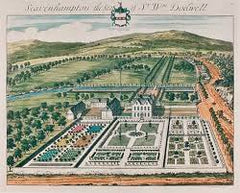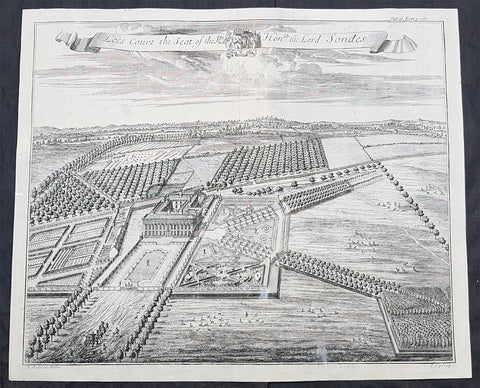
Johannes Kip 1653-1722
Johannes Kip was a Dutch draughtsman, engraver, and print dealer who was active in England, after producing works for the court of William of Orange in Amsterdam. Following the Glorious Revolution of 1688, Kip accompanied the Court to England and settled in Westminster, where he conducted a thriving print selling business from his house in St. John's Street.
He also worked for various London publishers producing engravings, largely for book illustrations. His most important works were the execution of the illustrations for Britannia Illustrata, 1708; The Ancient and Present State of Gloucestershire, 1712, and Le Nouveau Theatre de la Grande Bretagne, 1715.
Johannes (Jan) Kip (1)
1719 J. Kip Antique View House & Garden of Lees Court, Lord Sondes Kent, England
- Title : Lees Court the Seat of the Rt Hon.ble the Lord Sondes
- Size: 17 1/2in x 15in (445mm x 365mm)
- Condition: (B) Good Condition
- Date : 1719
- Ref #: 93116
Description:
This original copper plate engraved antique print a view of Lees Court and surrounding gardens, home of the Sondes family since the mid 17th century, located in the Swale district in the county of Kent, England was published in the 1719 Johannes Kips publication Britannia Illustrata or Views of Several of the Queens Palaces also of the Principal Seats of the Nobility and Gentry of Great Britain
Lees Court was built in 1652 on the site of an earlier house, by Sir George Sondes whose family had bought the estate in 1600. The front of the house is said to have been after a design by Inigo Jones. Sir George was made Earl of Feversham shortly before his death in 1677, and was succeeded in the estate and title by his son-in-law, Louis, Lord Duras of Holdenby. By the early 18c the house had been surrounded by an extensive arrangement of formal gardens, presumably at the direction of Duras, and these are recorded in engravings by Kip and by Badeslade (both in Harris 1719). When Duras died in 1709, the Lees Court estate passed to his late wife\'s sister, Sir George Sondes\' younger daughter. She was married to Lewis Watson, Lord Rockingham, who was created Earl of Rockingham in 1714. On his grandson Thomas Watson, 3rd Earl of Rockingham\'s death in 1746 Lees Court was inherited by a cousin, Lewis Monson, who took the additional name of Watson and was later raised to the peerage as Baron Sondes. Towards the end of the C18 Sir John Soane was commissioned to build new stables, estate offices, and a dairy at a time when changes were underway in the park. In the first decade of the C20 the C17 house was badly damaged by a fire and the Sondes family employed the architects Edward Hoare and Montagu Wheeler to rebuild it. In 1908 Mrs Gerald Leigh, who had leased the estate from Lord Sondes, commissioned Thomas H Mawson (1861-1933), assisted by Robert Atkinson to lay out formal gardens beneath the south-east front. Although leased at times throughout its history, Lees Court remained in the ownership of the Sondes family until the mid 1970s
General Definitions:
Paper thickness and quality: - Heavy and stable
Paper color : - off white
Age of map color: -
Colors used: -
General color appearance: -
Paper size: - 17 1/2in x 15in (445mm x 365mm)
Plate size: - 17 1/2in x 15in (445mm x 365mm)
Margins: - Min 1/2in (12mm)
Imperfections:
Margins: - None
Plate area: - Print backed with contemporary paper on top left verso
Verso: - Repair as noted
Background:
Britannia Illustrata, also known as Views of Several of the Queens Palaces and also of the Principal Seats of the Nobility & Gentry of Great Britain is a 1707–09 map plate folio of parts of Great Britain, arguably the most important work of Dutch draughtsman Jan Kip, who collaborated with Leonard Knijff. The folio consisted of a range of large, detailed folded colored and black and white drawings which today provides a valuable insight into land and buildings at country estates at the time.
The volume is among the most important English topographical publications of the 18th century. Architecture is rendered with care, and the settings of parterres and radiating avenues driven through woods or planted across fields, garden paths gates and toolsheds are illustrated in detail, and staffed with figures and horses, coaches pulling into forecourts, water-craft on rivers, in line with the traditions of the Low Countries. Some of the plates are in the Siennese map perspective. At Althorp in Northamptonshire, the map revealed in detail the changes to the gardens by André Le Nôtre from earlier maps and depictions. Kip updated the plates in the 1720s.

